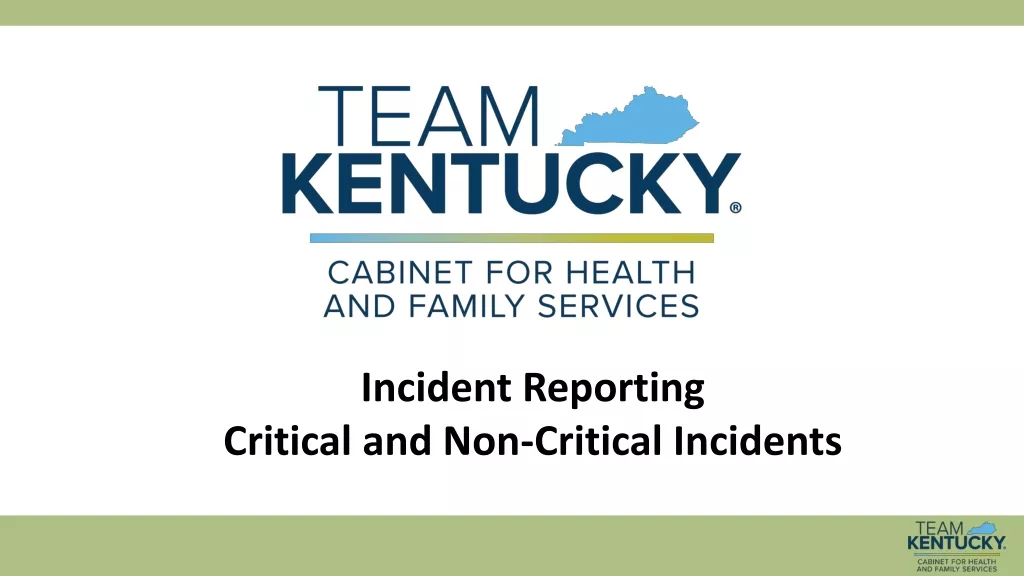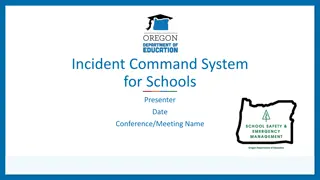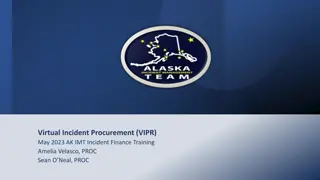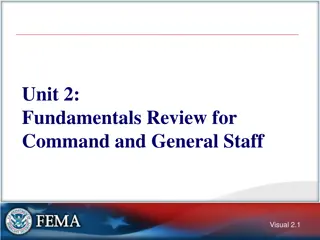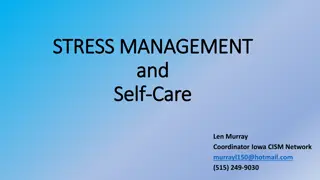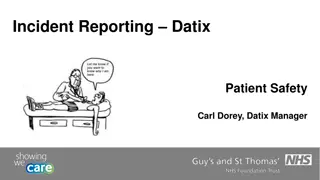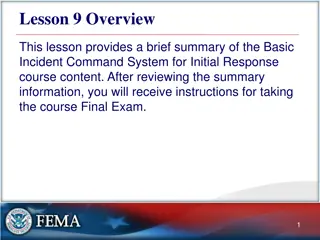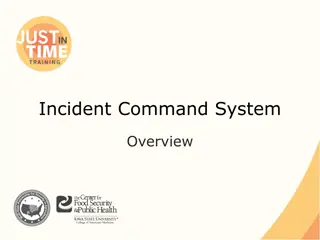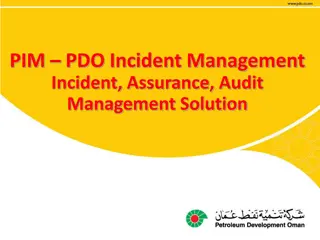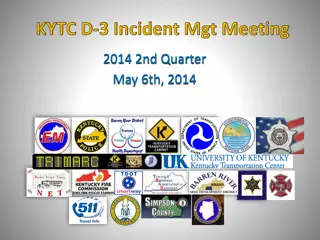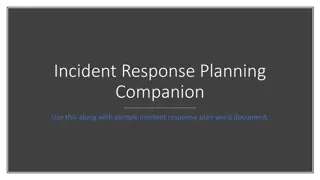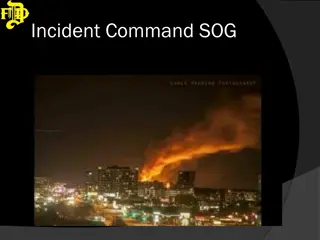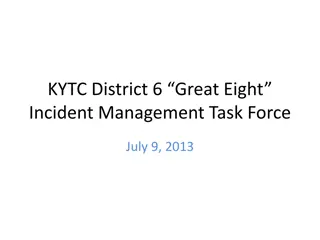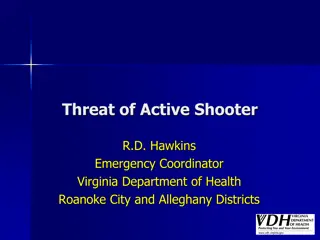Critical Incident Management
Incidents can disrupt activities, require dedicated structures; preparedness is vital for success in incident management. Challenges include surprise events, time pressure, lack of control, chaos, and stress. Critical incidents significantly disrupt operations, cause severe consequences, or threaten an organization's reputation. Principles of people-first approach, ownership, visibility, communication, and quick action are key for effective incident management.
Download Presentation

Please find below an Image/Link to download the presentation.
The content on the website is provided AS IS for your information and personal use only. It may not be sold, licensed, or shared on other websites without obtaining consent from the author.If you encounter any issues during the download, it is possible that the publisher has removed the file from their server.
You are allowed to download the files provided on this website for personal or commercial use, subject to the condition that they are used lawfully. All files are the property of their respective owners.
The content on the website is provided AS IS for your information and personal use only. It may not be sold, licensed, or shared on other websites without obtaining consent from the author.
E N D
Presentation Transcript
Critical Critical Incident Incident Management Management
Managing Incidents Managing Incidents Most incidents handled through regular line management. Exceptional situations can arise which, due to the nature and severity of the incident, require dedicated structure and process to respond. Preparedness is vital for the successful management of any incident, especially where a coordinated and effective response, involving different locations and stakeholders, is required.
Key Challenges Key Challenges Element of surprise Element of surprise - incidents/events can happen without warning. Time pressured Time pressured - quick response required. Fast moving Fast moving - events outpace responses, especially in early stages. Lack of control Lack of control - insufficient information, limited resources, no obvious solutions. Chaos and confusion Chaos and confusion conflicting information. Requires resilience Requires resilience - can take days, weeks, months to resolve. Affects the whole organisation Affects the whole organisation - normal decision-making and activities are disrupted. Extremely stressful Extremely stressful - those involved may require support during and afterwards.
What is a Critical Incident? What is a Critical Incident? Any incident that significantly disrupts disrupts activities and operations; results in severe consequences consequences for staff or others (serious injury or illness); or threatens the threatens the reputation reputation of the organisation. significantly Severity Severity severe Critical Critical Incident Incident Media Media Interest Interest Responsibility Responsibility
Triggers Triggers People People Operations Operations Reputation Reputation
Key Principles Key Principles People first People first Take ownership Take ownership Be visible Be visible Communicate and Communicate and collaborate collaborate Act quickly Act quickly Record everything Record everything Successful management of an Successful management of an incident depends on good decisions incident depends on good decisions being taken quickly, clearly defined being taken quickly, clearly defined responsibilities, and effective responsibilities, and effective channels of communication. channels of communication.
Management & Decision Management & Decision- -making making Critical incident management takes place at different levels: Individual Field Team Incident Management Team Incident Management Team (IMT) (IMT) Country Office Regional Office Crisis Management Team Crisis Management Team (CMT) (CMT) Headquarters
Structure & Roles Structure & Roles Any Critical Incident Critical Incident involving staff triggers the Country-level IMT. The IMT, in coordination with the HQ CMT, manages all aspects of the incident. IMT/CMT coordinate support to victims and family, and manage relations with authorities, other NGOs, and media. All staff must adhere to instructions issued by IMT/CMT. Specialist external assistance providers may also support the organisation during an incident medical care, security advice, psychological support.
Incident Management Team Incident Management Team Core IMT functions Overall coordination and management of IMT. The Coordinator normally reports directly to HQ CMT, if established. Coordinator Coordinator Advises on HR policy and coordinates all personnel, family support, and insurance aspects of the critical incident response. Human Resources Human Resources Programmes & Programmes & Operations Operations Advises on programme activities, relevant stakeholders and coordinates all communication with government stakeholders. Advises on security and safety issues and liaises with other organisation s security focal points. Staff Security & safety Staff Security & safety Communications & Communications & Media Media Advises on media issues and coordinates all media activity and all internal communications. Information Information Management & Support Management & Support Supports the IMT and maintains information records during the response.
Incident Management Plan Incident Management Plan Provides a framework to assist management in resolving critical incidents involving staff. Defines what incidents or events are considered critical. Identifies members of an IMT and alternates. Outlines the roles and functions involved in responding to a critical incident. Highlights immediate actions, key responses, and the post-incident support needs associated with most critical incidents. Plans should be reviewed and updated Plans should be reviewed and updated annually or following the activation of the IMT annually or following the activation of the IMT
Critical Incident Response Critical Incident Response
Intial Response Intial Response Establish facts Establish facts - confirmed, assumptions & source. Start log Start log - - record all events, comms & decisions. Analyse situation & options Analyse situation & options - incident, scenarios (most likely & worst case), priorities & risks. Map stakeholders Map stakeholders - who is affected/involved? Who deals with which stakeholder? Manage information Manage information - identify (internal & external) limitations or confidentiality. Support staff affected Support staff affected - medical, psychosocial, practical support. Support family Support family - notification, key messages, media support. Manage media Manage media - monitor coverage, agree media lines/statements. Identify support required Identify support required external advice, IMT alternates/rota.
Family Support Family Support Families first! Families first! - inform them first and maintain regular communication. Establish & maintain trust Establish & maintain trust - be honest! Determine what level of information they want. Identify who is the family Identify who is the family Next of kin/emergency contacts, develop family profile. Establish single point of contact Establish single point of contact - - introduce family support person as early as possible. Provide information Provide information - family support pack, resources, etc. Keep them on board Keep them on board - provide regular briefings/updates, discuss scenarios. Ensure psychological support is offered from outset Ensure psychological support is offered from outset - - help identify support networks. Help them deal with the media. Help them deal with the media. Expect fluctuating attitudes from the family Expect fluctuating attitudes from the family.
Managing Communications Managing Communications Always be proactive Always be proactive - anticipate events/outcomes, prepare draft statements/press releases. Monitor media coverage Monitor media coverage - local, national, international & social media. Develop clear communications strategy/media lines. Develop clear communications strategy/media lines. Ensure messages/statements demonstrate three Cs Ensure messages/statements demonstrate three Cs - - your Concern your Control Control of the situation and you re doing everything possible, and your Commitment resolving the incident, identifying why it occurred and ensuring it doesn t happen again. Ensure consistent approach Ensure consistent approach - partners, other stakeholders. Consult family Consult family - inform family before issuing statement/press release. Brief staff Brief staff - inform them how to direct enquires and not to discuss externally. Log all media enquires and actions taken Log all media enquires and actions taken. Concern for all those involved, Commitment to
Post Post- -incident & After Action Review incident & After Action Review Ensure quick access to safe environment & health care. Ensure quick access to safe environment & health care. Provide access to psychological support Provide access to psychological support - deploy as soon as possible in a safe location. Minimise media intrusion Minimise media intrusion - affected staff, families, colleagues. Manage and support return to work. Manage and support return to work. Ensure appropriate aftercare and support for IMT members and other staff affected Ensure appropriate aftercare and support for IMT members and other staff affected - psychological support, leave, return-to work plans. Determine IMT close down procedures Determine IMT close down procedures - ensure all documents/logs are collated. Initiate After Action Review Initiate After Action Review - determine why the incident occurred, actions and decisions taken in response, and if it could have been prevented or managed more effectively.


